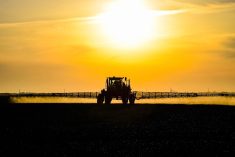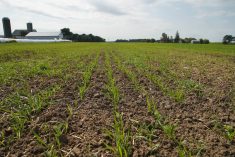Ryan Jaspers uses a combination of nitrogen sources, including dairy manure and ESN, to consistently achieve 75 bu./ac. canola yields.
Jaspers farms at Slate River, a few miles southwest of Thunder Bay, and he has a productive canola formula and climate.
His farming region isn’t big. Grain crop area is maybe 10,000 acres, while tame forage, silage and livestock account for most of the local agriculture economy. Jaspers’ farm is south of the 49th parallel, on a line that, when extended west, would run about 90 kilometres south of Winkler, Man., and Estevan, Sask.
Read Also

The forced Japanese-Canadian farmers of the Second World War
Manitoba’s sugar beet farms drew on displaced Japanese-Canadians from B.C. during the Second World War
That in itself is not much of an advantage. Proximity to Lake Superior may be.
“The lake makes it cooler here in the summer. Locations one hour west tend to be 5 C to 6 C warmer. We also cool off more at night,” Jaspers says. “I think it’s ideal for canola.”
Rainfall in the past two years has been on the dry side, Jaspers says, but in his 15 years of farming, he hasn’t had anything he would consider a drought. Annual rainfall is typically 635 to 710 millimetres (25 to 28 inches) including 400 mm (16 inches) during the growing season.
Soil type varies, Jaspers says. On the home farm at Slate River, where the family has a dairy, soil is generally clay loam and very productive. Land closer to the Kaministiqua River is sandier. Canola yields on the home farm, which also gets the manure, are 75 to 80 bu./ac., he says, while yields on sandier land are 60 to 65 bu./ac.
The full fertilizer formula
For the good clay loam closer to the home farm, Jaspers targets annual nitrogen fertilizer applications that total 180 pounds of actual nitrogen, on average. This includes soil reserves. “We soil test every year,” he says.
His typical nitrogen fertilizer program includes four products: 100 to 120 lb. per acre of ammonium sulphate (21 to 25 lb./.ac. of actual N), 100 to 125 lb. per acre of ESN (44 to 55 lb./ac. of actual N), 4,000 gallons per acre of dairy manure, which would be around 32 lb./ac. of actual N, and finally, urea applied at variable rates based on soil reserves and zone yield potential.
The ammonium sulphate and ESN go on together in the first spring pass, applied with a BBI spinner spreader. This blend also includes monoammonium phosphate, potash and boron based on soil tests.
Variable rate urea goes on with a second pass, again using the VR-equipped BBI spinner. Jaspers hires Crop Care Consulting of Brandon, Man., to create his prescription maps. After application, he cultivates to incorporate the fertilizer.
This fertilizer plan is based on recommendations from local research scientist Tarlok Singh Sahota, director of the Lakehead University Agricultural Research Station. The station is near Jaspers’ farm. Average soils at the station have 4.1 per cent organic matter and 6.3 pH.
Sahota has done a lot of fertilizer research, especially on ESN, and his results have been a big influence on local farmers.
“We use ESN on all of our crops, and the idea came from Tarlok’s research,” Jaspers says.
Sahota has been researching the slow-release polymer-coated urea product since 2006. He started on timothy, spring wheat and winter wheat and added canola in 2016. He published a summary of 12 years of ESN research in the Journal of Agricultural Science and Technology in 2020.
As described in that article, Sahota’s canola research from 2016 to 2018 showed that a blend with two-thirds nitrogen from urea and one-third from ESN increased canola yield by 0.75 tonnes per hectare compared to urea alone. This is based on total applications of 180 kg/ha (160 lb./ac.) of actual nitrogen.
It’s important to note this yield difference is based on plot yields of 6.66 tonnes per hectare (119 bu./ac.) for the blend and 5.92 t/ha (105 bu./ac.) for straight urea.
In the article, Sahota acknowledges these results are different from other ESN trials done on the Prairies. In general, research from the Prairies showed that “urea applied as an in-soil band at the time of seeding was generally as or more effective than similarly-placed ESN, split application of urea, or blended urea and ESN in increasing early season dry matter yield and seed or grain yield of canola, wheat or barley,” he wrote.
However, he adds, these results are based on banding, which is a good practice to minimize loss. For his studies, nitrogen fertilizer is broadcast and then incorporated, which is the common practice around Thunder Bay.
Spring broadcast and incorporation also works from a “right time” and “right place” perspective. And ESN can be a “right source” in this situation.
How does ESN increase yield? Sahota says it simply extends the release of available nitrogen over a longer time, so there’s more left at the end of the season for seed fill. These benefits, Sahota says, more than make up for the cost of ESN, which is, based recent correspondence from suppliers, typically $145 to $150 more per tonne than regular urea.
Sahota’s 180 kg/ha (160 lb./ac.) nitrogen stacking recommendation, which “canola growers all over Ontario, especially the Thunder Bay canola grower have been following,” he says, is 30 kg/ha of nitrogen from ammonium sulphate (21-0-0-24), 100 kg/ha from urea (46-0-0) and 50 kg/ha from ESN (44-0-0). This would be applied just before seeding and then incorporated with the seeding pass.
As part of his canola formula, he also recommends fungicide at the appropriate time to avoid the risk of sclerotinia stem rot.
“These practices result in very good yields,” Sahota says. “None of our farmers have got less than 1.4 to 1.5 tonnes of canola per acre. My goal is to get them to two tonnes per acre.” Converted to Prairies-speak, yields are not less than 62 to 66 bu./ac., and his goal is 88 bu./ac.
The complete canola campaign
Jaspers, like most farmers in the Thunder Bay area, has livestock – dairy cattle. The dairy provides a soil-enhancing shot of manure to fields near the main yard every year or two. While the nitrogen component is factored into his nitrogen program, other nutrients and organic matter from the manure also contribute to crop yield.
He seeds canola with a John Deere 1780 planter with 15-inch row spacing, using a seeding rate of 250,000 seeds per acre. This is just under six seeds per square foot.
Jaspers says he tried seeding canola with an air drill, but wasn’t comfortable with how it metered out. He bought a corn planter, which has discs for canola seed, and uses it for canola and corn.
“I really like the depth control.”
In addition to his spinner-applied fertilizer, Jaspers adds 15 litres per acre of liquid 6-24-6 in the seed row at planting.
With the precise depth and seed spacing of planted canola and with usually decent spring moisture, six seeds per square foot result in a uniform stand of five or six plants per square foot. This is within the Canola Council of Canada’s recommended target of five to eight plants per square foot for yield potential and lower input costs.
More plants mean the crop is more competitive against weeds, has more plant tissue per flea beetle and will mature a bit earlier because plants have fewer branches. Uniform seed depth also contributes to uniformity of crop growth, which gives the best bang from fungicide application and makes harvest timing easier.
Flea beetles “are definitely here,” Jaspers says, but he has never sprayed for them. However, he has applied fungicide on canola to manage sclerotinia stem rot in recent years. With his thick canopies and yield potential, the fungicide provides “a good return,” he says.
All his land is tile drained.
The farm’s rotation includes silage corn, forages, spring wheat, barley and canola. Canola rotation is usually one in three, and sometimes one in four. Jaspers grew L255P and L356P in 2022, choosing InVigor LibertyLink hybrids to balance whole-rotation weed management with his Roundup Ready corn.
Ultimately, the whole farm program is geared toward higher yields. Nitrogen isn’t the only part, but it’s a big part of achieving the land’s potential.
“Don’t compromise on nutrients,” Sahota says. “You can’t get high yields without them.”
– Jay Whetter is an agriculture journalist and communications manager for the Canola Council of Canada.














